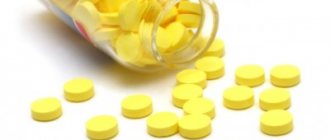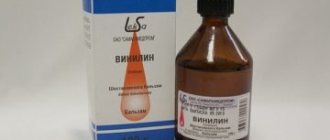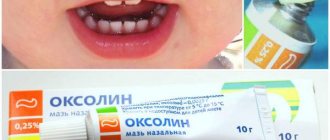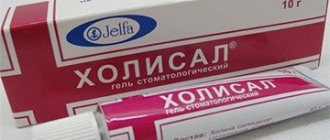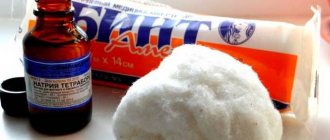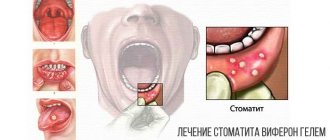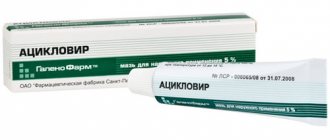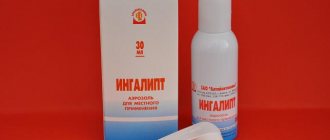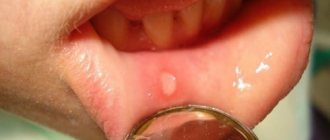Stomatitis is rightfully considered a childhood disease, since the pathology mainly affects young children under 5-7 years of age. But due to improper hygiene, bad habits and a number of other reasons, the disease can also occur in adult patients. The pathology is characterized by the appearance of small ulcers, which can be very painful and fester.
If timely treatment is not carried out, the disease worsens significantly, and eventually even necrotic processes may begin. The use of antibiotics for stomatitis can only be initiated by a dentist, since they are not used for all forms of the disease.
What antibiotics and medications to take for stomatitis
Important information about antibiotics for stomatitis
When using this group of medications, it is important to consider the following:
- they are not used for herpetic and allergic forms of stomatitis, they are rarely used for the aphthous type of disease;
- if prescribed incorrectly or due to individual intolerance to antibacterial agents, the pathology can increase several times;
- Broad-spectrum drugs are usually prescribed for treatment;
- it is important to conduct a laboratory test to identify the sensitivity of pathogenic microflora, which will allow for quick and effective treatment;
- The use of antibiotics in children is carried out only in exceptional cases when a complex form of disease of the oral mucosa develops.
Attention! For herpetic and aphthous forms of the disease, it is important to use drugs that are aimed at directly destroying the cause. These can be antiviral agents, immunomodulators and antiseptics.
Application and indications
The medicine Grammidin has a pronounced therapeutic effect for infections of the throat, gums and tongue.
Indications for use:
- pharyngitis
- stomatitis
- gingivitis
- angina
- tonsillitis
- periodontal disease
Grammidin tablets have a pleasant mint taste. However, this does not mean that the drug can be taken uncontrolled.
Before you continue reading: If you are looking for an effective method of getting rid of a runny nose, pharyngitis, tonsillitis, bronchitis or colds, then be sure to look at this section of the site after reading this article. This information has helped so many people, we hope it will help you too! So, now back to the article.
Preparations in the form of injections for stomatitis
Lincomycin
The drug Lincomycin in the form of ampoules
In one day, a patient with an average development of the disease is prescribed no more than 1.8 g of Lincomycin. It is recommended to administer 0.6 g of the active substance at a time, the interval between doses should be at least 6-8 hours. If the disease has developed into a severe form, the amount of Lincomycin can be increased to 2.4 g. In extreme and exceptional cases of the patient's condition, a maximum daily dose of 8 g of antibiotic can be prescribed. The average course of therapy is 7-14 days.
Claforan
The drug Claforan
The duration of use of the antibacterial drug for each patient is determined individually; the dose also depends on the degree of development of the disease. With the development of bacterial stomatitis, a single dose can be 1-2 g of the main component. The drug is administered every 8-12 hours, taking into account the severity of the symptoms of the disease.
Biotax
The medication can only be taken if your body weight is over 50 kg. Taking into account the severity of stomatitis and its damage to the oral mucosa, patients are administered 1-2 g of the active substance. The number of daily doses is 2-6 times; for moderate illness, the drug is administered no more than three times a day. With the development of necrotic processes, Biotax can be administered every six hours. The duration of therapy is selected individually.
Attention! Injections are usually used in combination with the tablet form of stomatitis, which is necrotic and ulcerative in nature. It is important to carefully monitor the patient's condition, since such a scheme is considered very aggressive, but at the same time gives quick results.
When does Grammidin not help, and when does it cause harm?
Sometimes the only reason a patient refuses treatment with Grammidin tablets is reviews. Having read information on forums in which reviews of the drug sometimes differ in the most dramatic way, a person suffering from chronic pharyngitis flatly refuses to take such a controversial medicine.
He refuses completely in vain. And not at all because the reviews about Grammidin are not true. Quite the contrary, in most cases, reviews of the drug are not embellished or discredited; each person simply talks about whether the drug helped him or not. And here everything depends on the competence of the doctor who prescribed the pills, the type of disease and the ability to carefully read the instructions in the instructions.
Thus, Grammidin is contraindicated in case of allergy to gramicidin and should be used with great caution if there have been cases of allergies to other antibiotics in the anamnesis.
The same applies to the second bactericidal component of the drug - cetylperidinium chloride.
If, when prescribing Grammidin, the doctor focuses only on the diagnosis (pharyngitis, stomatitis, etc.) and the patient’s condition (red throat, laryngeal edema, hacking cough), but does not take into account the allergy status, then reactions to the medicine can be very dangerous, and in this case there are no benefits there won't be much from it.
If, when choosing Grammidin for the treatment of throat and cough, the price is the only thing that interests the patient, then it is not surprising that the result will not always please you either.
For example, allergic stomatitis or gingivitis cannot be cured with Grammidin. At best, you won't notice any reaction. At worst, the use of the drug will worsen the course of the disease.
Augmentin for the development of stomatitis
Augmentin is in most cases used to treat severe stomatitis.
A very powerful drug that can eliminate many types of infectious diseases. The medication contains amoxicillin, which has the main antibacterial effect. Its effect is enhanced by the presence of clavulanate. This component inhibits the production of bacterial beta-lactamase.
Augmentin is in most cases used to treat severe forms of pathology. The dosage of amoxicillin can be 500 or 875 mg at a time, with an additional 125 mg of clavulanate taken in both dosing cases. The drug is taken three times a day one hour before the main meal. The maximum course of therapy is 14 days.
Attention! It is the presence of clavulanate that ensures the good effectiveness of the drug. This composition allows the antibiotic to be fully absorbed without being exposed to harmful organisms.
Use during pregnancy: why not?
Grammidin is not prescribed during pregnancy due to the possible adverse effects of its components on the body of the woman and the fetus.
This medicine also does not treat the throat during feeding. If the doctor persistently recommends that a nursing mother treat pharyngitis with Grammidin, breastfeeding must be stopped during the course of therapy.
You need to understand that taking the drug during pregnancy or breastfeeding can provoke metabolic disorders, immunosuppression, and allergization.
Amoxiclav against stomatitis in adults
Broad-spectrum drug Amoxiclav
A broad-spectrum drug that helps well in cases where local therapy has not produced any results or very weak positive dynamics are observed. When treating stomatitis, Amoxiclav has a systemic effect, quickly eliminating the source of infection in the oral cavity. After the first use, the product begins to inhibit the synthesis of development of pathogenic organisms.
Taking into account the severity of the symptoms of the disease, the amount of the active substance can be 0.25-0.5 g of Amoxiclav. The drug is taken three times a day. Sometimes a single dose can be 1 g of tablets also three times a day after 8 hours. The duration of therapy is 7-14 days.
Attention! The drug is available in three pharmacological forms. They have an equally good effect on the body, so the patient can independently choose powder, tablets or drops. But liquid forms are usually prescribed for children.
Composition and release form
There are two types of the drug: Grammidin Neo and “Neo with anesthetic”. Do not look for the drug in solution or capsules and do not believe those who offer to buy the drug in the form of a spray or ointment. The only dosage form of Grammidin is tablets.
Please note that the medicine is available in the form of lozenges (so-called buccal tablets) and, in fact, acts locally, without entering the bloodstream or accumulating in the body.
Grammidin tablets are packaged in blisters and packaged in cardboard boxes of different colors. The packaging of the drug is made in green colors (regular) or red (“Neo with anesthetic”).
Amoxicillin to suppress infection
The drug Amoxicillin
This drug is prescribed when stomatitis is caused by diseases of the internal organs. This happens when the infection spreads through the bloodstream. In this case, Amoxicillin is used to stop the underlying pathological process.
To relieve stomatitis that occurs as a secondary symptom, 250-500 mg of the drug is prescribed. This amount of Amoxicillin is taken three times a day. The duration of therapy is 10 days; with a milder degree of damage, the course of treatment can be reduced to 7 days.
Attention! When using Amoxicillin, it is recommended to carry out local therapy, which may consist of rinsing and treating the oral cavity with antiseptics, including Furacilin and Hexidine.
How to use for adults?
The instructions recommend using the drug in the form of a spray "Orasept" for both viral and bacterial infections of the mucous surface of the mouth and throat. The product is sprayed only in the oral cavity. After irrigation, a small amount of medicinal liquid remains in the mouth, which can be swallowed.
Adults are advised to spray the medication every 2-3 hours, pressing the spray nozzle 5 times. The attending physician can adjust the treatment regimen with an antiseptic. The duration of treatment will depend on the clinical effect and tolerability of the spray components.
According to the instructions, Orasept combines well with other medications (including oral antiseptics), and therefore it is better to use it as part of complex therapy.
Metronidazole for stomatitis relief
The drug Metronidazole
The main active ingredient of the drug is the substance of the same name. If it is necessary to use the drug, an adult patient is prescribed 1.5 g of the active substance. This amount of Metronidazole is divided into three uses. The duration of therapy is one week, in some cases treatment can last up to 10 days.
If oral administration does not provide the desired result, a decision may be made to use intravenous infusions. This is usually done when necrotic processes develop, which can be accompanied by ulcers and severe pain. In this case, treatment involves administering 500 mg of Metronidazole over five minutes. The procedure can be repeated three times.
Attention! Metronidazole is most often used in tablet form. At the same time, it is advisable to combine it with injections of Lincomycin, Claforan and other injections.
general description
During the cold season, most people experience inflammatory and infectious diseases, which are usually accompanied by pain and discomfort in the throat area.
Preparations in the form of sprays intended for spraying in the oral cavity will help fight the first signs of the disease. They usually contain components that eliminate pain and negatively affect the viability of pathogenic microflora. A medicine for the treatment of various inflammatory, infectious and bacterial ailments of the throat and oral cavity is Orasept (spray). The instructions for use indicate that the drug contains phenol. The substance is an active component and has both anti-inflammatory, bactericidal and analgesic effects.
Glycerin (softens mucous membranes), sodium saccharin, purified water, dye and cherry flavor are used as auxiliary components. Experts say that the spray is quite powerful and can cope even with acute sore throat.
Suprax for stomatitis relief
Suprax in capsule form
The drug is available in capsule form. It is most often used in ENT practice, but it also perfectly helps to stop foci of infection that are associated with the development of dental pathologies. Suprax is taken strictly once a day, the dosage is 400 mg of the active substance. The recommended course of therapy is 10 days; with a milder form of stomatitis, the duration of treatment can be 7 days.
If necessary, Suprax can be replaced with Pancef, which is available in tablet form. This allows you to prescribe a different treatment regimen, which involves taking 200 mg of the active ingredient in the morning and evening. The duration of therapy with this antibiotic is also 7-10 days.
Attention! Suprax is a third generation semi-synthetic antibiotic. This determines its rapid effect and good tolerance. If all doses are followed and there are no contraindications, side effects occur very rarely and are most often associated with intestinal problems.
Instructions for use, dosage
Suprax for children (the dosage of the drug must be selected by a pediatrician, as it depends on the weight and age of the child, the diagnosis and the characteristics of the disease) is most often prescribed in the form of granules, from which an effective suspension is prepared.
For these purposes, it is recommended to use still water without preservatives and sweeteners. It is forbidden to dissolve granules in hot water.
When preparing the suspension, the manufacturer of the drug Suprax recommends adhering to the following scheme:
- The container with granules must be shaken carefully. To prepare the suspension, you can use Suprax Solutab tablets. To do this, just grind 1 tablet into powder and dilute the resulting product with water.
- 20 ml of still water is poured into a jar of granules. The bottle must be shaken several times to obtain a homogeneous mass.
- You need to add 20 ml of water to the jar again. The suspension should be allowed to stand for 10 minutes for the granules to completely dissolve.
- Before each use, the medicine should be shaken thoroughly.
The prepared suspension can be stored for a maximum of 14 days. After this period of time, unused product must be disposed of. Suprax is an effective antibiotic that can only be taken after prior consultation with your doctor, since safe treatment of a diagnosed pathology requires adherence to the exact dosage of the drug.
The dose of the drug is calculated based on the patient’s age:
- For children under 1 year of age, pediatricians prescribe 2.5-4 ml of suspension 2 times a day.
- If the child is between 2 and 4 years old, then the dosage should be increased to 5 ml. The drug is taken in the morning, at lunch and in the evening.
- For children from 5 to 12 years old, the suspension is given 6-10 ml 3 times a day.
- Adults and children over 12 years of age can take the drug once a day in a dosage of 20 ml.
Treatment should last at least 10 days. If the prescribed drug therapy is interrupted ahead of time, then some of the pathogenic bacteria will not die, but will become resistant to the components of the drug.
The drug can be mixed with drink or food, as this does not affect the final effectiveness of the treatment. To prevent the development of dysbiosis and stomatitis, pediatricians recommend taking probiotics along with the antibiotic Suprax, which will help normalize the intestinal microflora.
Cost of antibiotics against stomatitis
| A drug | Image | Price in Russia in rubles | Price in Belarus in rubles | Price in Ukraine in hryvnia |
| Lincomycin | 150 | 5 | 62 | |
| Claforan | 150 | 5 | 62 | |
| Biotax | 100 | 3,2 | 41 | |
| Augmentin | 250 | 9 | 102 | |
| Amoxiclav | 150 | 5 | 62 | |
| Amoxicillin | 50 | 1,6 | 21 | |
| Metronidazole | 100 | 3,2 | 41 | |
| Suprax | 800 | 25 | 287 | |
| Pantsef | 600 | 19 | 246 |
Attention! The given medications have analogues according to the scheme of action, but they can be replaced with each other only with the permission of the attending physician, in order to prevent the development of necrosis or its intensification.
If you notice the signs of incipient stomatitis in time, you will be able to avoid the use of antibiotics. To do this, it is enough to rinse your mouth and use special ointments. But with recurrent forms, even with a mild degree of the disease, it may be necessary to take antibacterial therapy due to an excessively weakened immune system.
During treatment, it is important to strictly adhere to all dosages of antibiotics, since they can not only affect internal organs, but also provoke dysbacteriosis and vomiting. These symptoms will only worsen stomatitis and complicate its elimination.
Antiviral drugs for stomatitis
For traumatic, bacterial stomatitis, you can use the following antiseptic agents against stomatitis, most of them are complex drugs that, in addition to antibacterial, also have anti-inflammatory properties, accelerating the healing process.
| Chlorophyllipt oil solution is an antiseptic with bactericidal activity against staphylococci, used for bacterial stomatitis. Ingredients: a mixture of chlorophylls from the leaves of Eucalyptus rodum. Contraindicated in children under 12 years of age. Application: Treat the affected areas of the mucous membrane 1-2 times a day. Allergic reactions to Chlorophyllipt with stomatitis are possible. | |
| Cholisal is an effective remedy for all types of stomatitis, especially for fungal stomatitis. It has a local anti-inflammatory, analgesic and antipyretic effect. Ingredients: Choline salicylate and Cetalkonium chloride Indicated for children over 1 year of age. Application: apply 2-3 times a day after meals, before bedtime. For adults, squeeze out 1 cm of gel, for children, 5 mm onto a clean finger, rub into the affected areas in the oral cavity. | |
| Lugol spray is an iodine preparation that has an antiseptic effect. Ingredients: Potassium iodide and Glycerol. Contraindicated in children under 5 years of age. Application: 4-6 times a day, spraying Lugol spray with one click on the affected areas. | |
| Vinilin for stomatitis has an anti-inflammatory, antiseptic effect, cleanses wounds, promotes rapid tissue regeneration, and healing of ulcers. Composition: Active ingredient Polivinox Indicated for children over 1 year of age Application: Soak a cotton swab or cotton pad with Shostakovsky balm and gently lubricate the surface of ulcers and areas of inflammation. This medication should be used after meals and before bedtime 3 times a day. | |
| Ingalipt, Ingalipt-Vial - soluble sulfonamides included in the drug have an antimicrobial effect, Ingalipt is especially effective for aphthous stomatitis. Ingredients: Peppermint, thymol, sulfanilamide, eucalyptus oil, sulfathiazole. Application: Irrigate 3 times a day, spraying for 1-2 seconds. spray on the affected area. | |
| Ingafitol or Eucarom No. 1 collection for inhalation is an antimicrobial medicine of plant origin. Ingredients: Chamomile flowers and sage leaves Application: 2 tablespoons of the collection are poured with a glass of boiling water, left in a water bath for 15 -20 minutes. Young children should treat the mouth, and adults and children over 3 years of age should use it as a rinse. | |
| Rotokan is a solution of plant origin that has a local antiseptic, anti-inflammatory, hemostatic effect, and promotes the regeneration of the mucous membrane. Particularly effective for aphthous stomatitis. Ingredients: Calendula, chamomile, yarrow. Application: rinse or treat affected areas in the form of applications 3 times a day for 5 days. To do this, pour 5 ml of solution into 1 glass of warm water. | |
| Methylene blue dye - Blue - is a very effective remedy for stomatitis, has an antiseptic and analgesic effect, and is especially effective for fungal and herpetic stomatitis. Composition: Methylthionine chloride Application: methylene blue is used to treat ulcers and inflammation with a cotton swab dipped in the solution. The disadvantage is the strong staining of the mucous membrane of the mouth and skin in blue. | |
| Miramistin - for stomatitis, it is used as an antiseptic with antiviral and bactericidal effects. Ingredients: myristoylamino - propylammonium, benzyldimethyl. Application: Spray Miramistin spray at the site of inflammation of the mucous membrane 3-4 times a day. Instructions for use of Miramistin. | |
| Hexalize is a combined drug, an antiseptic with an antiviral, anti-inflammatory effect. Ingredients: Lysozyme, Enoxolone, Biclotymol. Application: 1 tablet each. every 2 hours, contraindicated in children under 6 years of age. |
The most common causative agent of stomatitis is the herpes virus; if it affects the oral mucosa, then local antiherpetic agents cannot be avoided. The doctor can select the appropriate medicine for stomatitis and prescribe a specific course of treatment, taking into account the person’s age, duration and presence of relapses of the disease.
| Viru-merz-Serol is a gel against the herpes virus, relieves pain, burning, itching, and shortens the duration of the disease. Composition: Tromantadine Application: Viru-Merz Serol gel is applied 3-5 times a day, lightly rubbing, for a course of 5 days, used for initial clinical symptoms, use is stopped when vesicles and bubbles form. | |
| Oxolinic ointment for stomatitis is also very effective, since it is an antiviral agent, highly active against herpes viruses, adenoviruses, and influenza viruses. Composition: Oxolin Application: Apply to affected areas in the mouth 2-3 times a day | |
| Bonafton ointment for stomatitis, with an antiviral effect, is active against adenoviruses and the Herpes simplex virus. Composition: Bromonaphthoquinone Application: ointment is applied to the lesions 3-4 times a day for 5-10 minutes. | |
| Acyclovir ointment, analgi Herperax, Acigerpin, Vivorax, Zovirax, Gervirax - antiviral creams and ointments used for herpetic stomatitis. Composition: synthetic analogue of thymidine nucleoside. Application: Acyclovir ointment or cream for stomatitis is applied to the affected areas every 4 hours, the course of treatment is determined by the doctor. | |
| Tebrofen ointment for stomatitis is used in cases of viral origin of inflammation, as it is an antiviral agent. Composition: Tetrabromotetrahydroxydiphenyl Application: 2% ointment to treat areas of inflammation 3 times a day for a week. |
Terms, conditions of sale and storage
All dosage forms of the antibiotic Suprax are sold according to a doctor's prescription.
The shelf life of the drug is 3 years. The medication should be stored in a dry, well-ventilated place, out of reach of children. The room temperature should be between +15 and +25 C.


